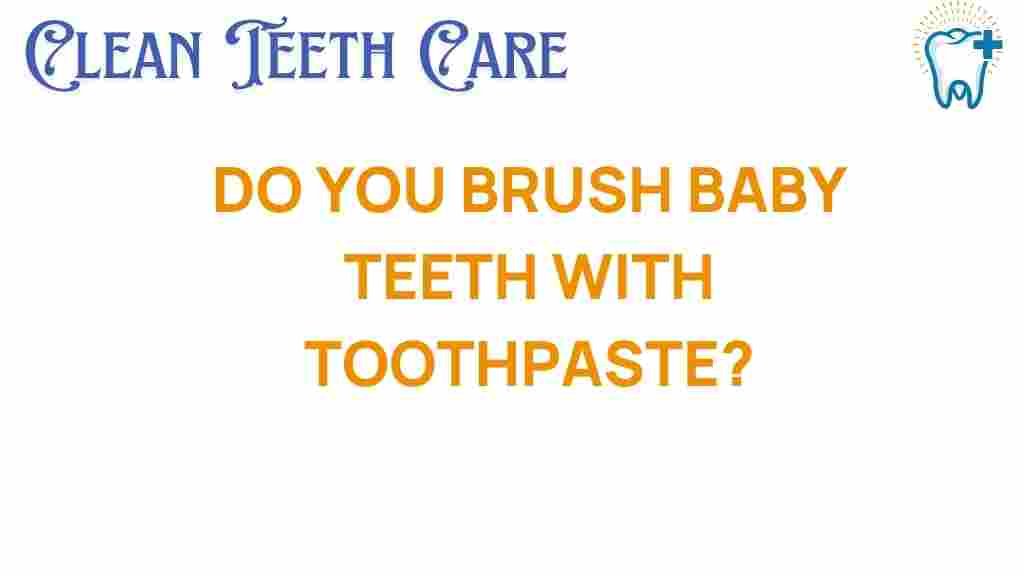The Toothpaste Dilemma: Should You Brush Baby Teeth with It?
When it comes to baby teeth, one of the most common questions parents face is whether or not to use toothpaste during brushing. As part of a comprehensive approach to children’s dental care, understanding the best practices for oral hygiene in young children is crucial. In this article, we will delve into the intricacies of brushing baby teeth, the importance of cavity prevention, and provide essential parenting tips for maintaining your child’s dental health.
Why Baby Teeth Matter
Many parents underestimate the significance of baby teeth. However, these first set of teeth play a vital role in a child’s overall health and development. Here are some reasons why baby teeth are important:
- Development of Speech: Baby teeth are essential for clear speech development.
- Guide for Permanent Teeth: They act as placeholders for permanent teeth.
- Facilitate Eating: Healthy baby teeth allow children to chew food properly, aiding digestion.
- Boost Self-Esteem: A healthy smile contributes to confidence as children grow.
Given their importance, ensuring proper oral hygiene from an early age is critical. Now, let’s explore if you should brush baby teeth with toothpaste.
Understanding the Role of Toothpaste in Early Brushing
When it comes to early brushing, the type of toothpaste you use can significantly impact your child’s dental health. Here’s what you need to know:
Types of Toothpaste for Baby Teeth
Not all toothpaste is suitable for baby teeth. Here are the common types:
- Fluoride Toothpaste: Recommended for children aged 2 and older, fluoride helps strengthen teeth and prevent cavities.
- Non-Fluoride Toothpaste: For children under 2, using a non-fluoride toothpaste is often advised to avoid the risk of fluorosis.
When to Start Brushing with Toothpaste
According to dental professionals, you can start brushing your child’s baby teeth as soon as they emerge. Here is a step-by-step process:
Step-by-Step Process for Brushing Baby Teeth
- Start Early: Begin with a soft, damp cloth or a finger brush to clean your baby’s gums even before teeth appear.
- Use the Right Toothbrush: Once the first tooth appears, switch to a soft-bristled toothbrush designed for infants.
- Choose the Right Toothpaste: For babies under 2, use a smear of non-fluoride toothpaste. For children aged 2-5, use a pea-sized amount of fluoride toothpaste.
- Brush Twice a Day: Aim to brush in the morning and before bedtime.
- Supervise and Teach: As your child grows, teach them how to brush properly, but supervise to ensure they do not swallow too much toothpaste.
Common Concerns and Troubleshooting Tips
As you start this journey of children’s dental care, you may face certain challenges. Here are some common concerns and how to address them:
Concern: Child Refuses to Brush
It’s common for young children to resist tooth brushing. Here are some tips to encourage them:
- Make it Fun: Use songs or fun toothbrushes to engage your child.
- Be a Role Model: Brush your teeth together to show them it’s a normal part of the routine.
- Offer Choices: Let them choose their toothpaste or toothbrush with their favorite characters.
Concern: Swallowing Toothpaste
Swallowing toothpaste can be a concern for parents, especially with fluoride toothpaste. Here’s how to mitigate this risk:
- Use a Small Amount: For children over 2, a pea-sized amount is sufficient.
- Educate About Spitting: Teach your child to spit out the toothpaste after brushing.
- Follow Up with Water: Encourage rinsing with water after brushing.
Additional Parenting Tips for Cavity Prevention
Maintaining optimal dental health for your child goes beyond just brushing. Here are some essential parenting tips for effective cavity prevention:
- Limit Sugary Snacks: Reduce sugary foods and drinks, which can lead to cavities.
- Encourage Water Intake: Water helps wash away food particles and bacteria.
- Regular Dental Visits: Schedule your child’s first dental visit by their first birthday or when their first tooth appears.
- Teach Proper Flossing: Once your child has two teeth that touch, start teaching them how to floss.
For more information on establishing good dental habits, you can visit this resource.
The Importance of Early Dental Checkups
One of the best practices for ensuring your child’s dental health is to schedule regular dental checkups. The American Academy of Pediatric Dentistry recommends that children have their first dental visit by age one. This early visit helps to:
- Identify any potential dental issues early on.
- Provide guidance on proper oral hygiene practices.
- Establish a relationship between your child and the dentist, reducing anxiety for future visits.
What to Expect During the First Dental Visit
During your child’s first dental visit, the dentist will typically:
- Examine your child’s teeth and gums for any issues.
- Discuss dietary habits and oral hygiene practices with you.
- Provide recommendations for future dental care.
Conclusion: Embracing the Toothpaste Dilemma
In conclusion, the toothpaste dilemma regarding baby teeth is an essential aspect of children’s dental care. By starting early with the right tools and practices, you can set your child on the path to excellent dental health. Remember to choose the appropriate toothpaste, establish a brushing routine, and encourage healthy habits that will last a lifetime.
As parents, your role in guiding your child’s oral hygiene cannot be overstated. Stay informed, be proactive, and embrace the journey of cavity prevention and early brushing for your little ones. With these tips, you can navigate the toothpaste dilemma with confidence!
This article is in the category Kids and created by CleanTeethCare Team
